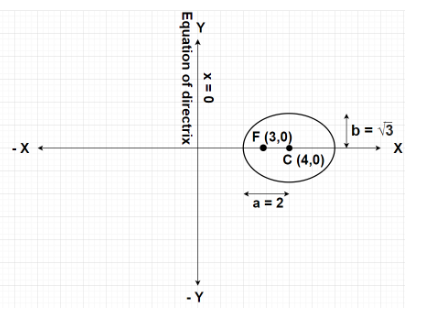Question
Question: If Y-axis is the directrix of the ellipse with eccentricity \(e = \dfrac{1}{2}\) and the correspondi...
If Y-axis is the directrix of the ellipse with eccentricity e=21 and the corresponding focus is at (3,0), find the equation to its auxiliary circle.
A. x2+y2−8x+12=0 B. x2+y2−8x−12=0 C. x2+y2−8x+9=0 D. x2+y2=4
Solution
Hint- Here, we will proceed by using the formulas for the equation of directrix i.e.,x=h−ea , the focus coordinates i.e., F(h-ae,k) and b2=a2(1−e2) corresponding to any ellipse a2(x−h)2+b2(y−k)2=1 where a>b.
Complete step by step answer:

Given, Directrix to the given ellipse is represented by equation of Y-axis i.e., x = 0
Eccentricity, e=21
Focus of the ellipse is at F(3,0)
Since, the directrix of the given ellipse lies along the Y-axis. Therefore, the ellipse will be oriented along the X-axis.
Let the equation of the ellipse along Y-axis is given by a2(x−h)2+b2(y−k)2=1 →(1) where a>b and the centre of the ellipse lies at point C(h,k).
As we know that the equation of the directrix to any ellipse a2(x−h)2+b2(y−k)2=1 (having eccentricity as e) where a>b is given by
x=h−ea
For the given ellipse, equation of the directrix is x = 0
⇒0=h−ea ⇒h=ea
By putting e=21 in the above equation, we get
⇒h=(21)a ⇒h=2a →(2)
Also, the focus coordinates for any ellipse a2(x−h)2+b2(y−k)2=1 (having eccentricity as e) where a>b is given by F(h-ae,k)
Also, focus of the given ellipse is F(3,0)
So, h-ae = 3
⇒2a−a(21)=3 ⇒2a−2a=3 ⇒24a−a=3 ⇒23a=3 ⇒a=2
Hence, a2=22=4
Also, k = 0
Using the formula b2=a2(1−e2), the value of b2 is given as
⇒b2=4(1−(21)2)=4(1−41)=4(44−1)=4(43) ⇒b2=3
Putting a = 2 in equation (2), we get
⇒h=2×2=4
Putting a2=4, b2=3, h = 4 and k = 0 in equation (1), we get
⇒4(x−4)2+3(y−0)2=1 ⇒4(x−4)2+3y2=1
This above equation represents the equation of the given ellipse.
Equation of the auxiliary circle to the ellipse a2(x−h)2+b2(y−k)2=1 where a>b is given by
(x−h)2+(y−k)2=a2 →(3)
By putting a2=4, h = 4 and k = 0 in the equation (3), we get
⇒(x−4)2+(y−0)2=4 ⇒(x−4)2+y2=4 ⇒x2+42−8x+y2=4 ⇒x2+y2−8x+12=0
The above equation represents the required equation of the auxiliary circle to the given ellipse.
Hence, option A is correct.
Note- In this particular problem, firstly it very important to find out that the given ellipse corresponds to which one of the two general cases of ellipse i.e., a2(x−h)2+b2(y−k)2=1 where a>b or a2(x−h)2+b2(y−k)2=1 where b>a, in order to use the formulas for various parameters. Also, the major axis of the given ellipse is X-axis and the minor axis is Y-axis.
